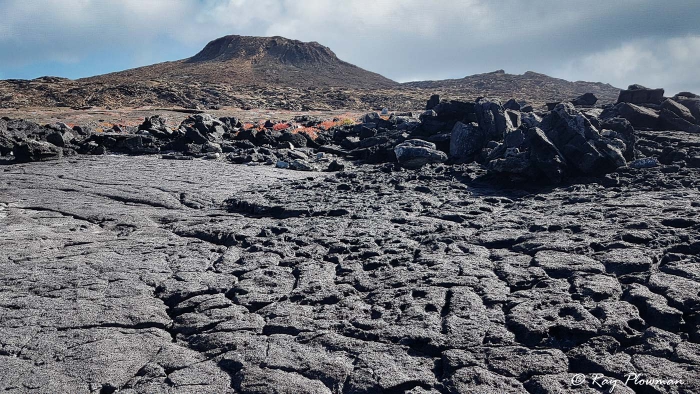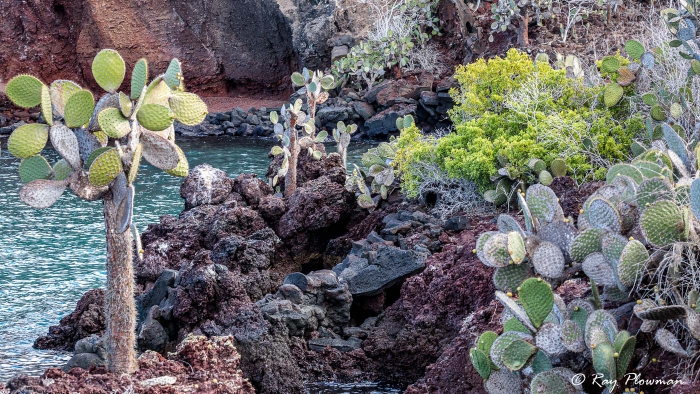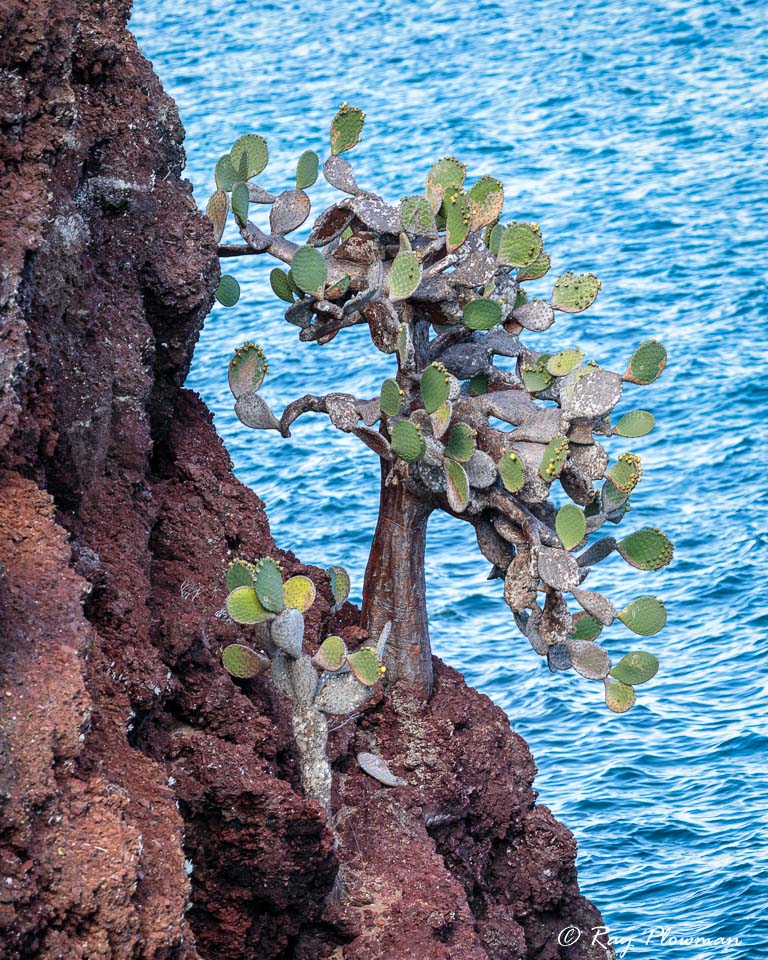Santiago – Sombrero Chino and Rabida Island
Our itinerary for the second day in the Galapagos comprised a visit to Sombrero Chino and Rabida Island.
Sombrero Chino
Sombrero Chino is a primal sterile-looking island home to marine wildlife. Further, a spatter cone formed a long time ago when Santiago’s volcano erupted and ejected lava and rocks. Over time the splatter cone has eroded and eventually separated from Santiago by a sea channel.
After an overnight voyage from Puerto Ayora, we anchored before sunrise at the end of Sombrero Chino. Also known as Chinese Hat, it is a small islet close to Santiago (James) Island. First, an early breakfast and a morning panga ride along Santiago’s southeast coast to view marine wildlife. Then, a wet landing and hike on Sombrero Chino’s rocky trail, followed by a panga ride along the islets coast.

Lava Fields at Sombrero Chino
The lava fields at Sombrero Chino are more recent than the older reddish spatter cone seen in the distance.
Isla Sombrero Chino Wildlife
[foogallery id=”16975″]
Wildlife at Isla Sombrero Chino
Wildlife encounters on our panga ride along Santiago’s southeast coast included the endangered Galápagos Penguins, Brown Pelicans and Lava Heron. It was a wet landing for a half-kilometre walk on Sombrero Chino’s west coast. Notable encounters were the endangered Galápagos fur seals on the beach and a Santiago lava lizard, an endemic subspecies.
After our walk, our panga returned to the boat via Sombrero Chino’s north coast, where we saw blue-footed boobies. The gallery features some of the wildlife I photographed. Still, I have not included a brown noddy, wandering tattler, or yellow warbler foraging on the lava rocks.
Rabida Island
Rábida Island (Jervis) lies at the centre of the archipelago, south of Santiago. And its lava is rich in iron oxide and magnesium; when exposed, it rusts, giving the island its reddish colour. Also, its vegetation is Opuntia cacti, Palo Santo trees, and scrub.
After lunch, we arrived at Rábida Island, anchoring off the sheltered east coast, allowing an opportunity for Kayaking. Moreover, it was mid-afternoon before we set off in the panga for Rábida’s red sand beach on the north coast. Also, it was time to get our feet, the second wet landing of the day.

Rabida’s Prickly Pear Cacti and Red Cliffs
Landscape showing Rábida’s red cliff and three endemic plants. Giant Prickly Pear Cactus (Opuntia galapageia var profuse), saltbush (Cryptocarpus pyriformis) and Palo Santo (Bursera graveolens).
Rabida Island Wildlife
[foogallery id=”16976″]
Wildlife on Rabida Island

The trail goes inland from the red sand beach and then makes a clockwise loop taking in the striking east coast red cliffs. Birds observed include Galápagos mockingbird, Galápagos dove, common cactus finch and medium ground finch. Furthermore, the trail goes east alongside the Flamingo Lagoon, alas no flamingos, just oystercatchers. Just before reaching the red sand beach photographed a small flock of mockingbirds and a medium ground finch. Also on red sands beach, wandering tattler and brown pelican.
After our walk, we boarded the panga, which stopped at several places along the coast. We photographed birds such as lava heron, brown noddy, blue-footed and Nazca boobies. Also, a Galápagos marine iguana ssp wikelskii found only on San Cristóbal and Santiago Islands including Rábida.
Bibliography – Online Resources
1. Galapagos Geology on the Web – Rabida 2021. [Online] Available from Galapagos Geology on the Web [Accessed 22-Sep-21].